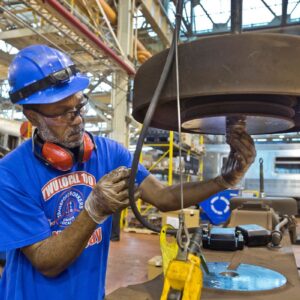
The following text is excerpted from: From Founder to Future: A Business Road Map to Impact, Longevity, and Employee Ownership (Berrett-Koehler Publishers, 2025). Reprinted here with permission of author and publisher.
Before embarking on a worker co-op conversion, I recommend that you take a sabbatical from work if you never have. You might need one anyway, and it may be the best possible way for you to assess whether you and your company are ready for conversion. Whether short or long, it’s sure to clarify plenty.
Another recommendation, for both owners and employees: review the Legal Guide to Cooperative Conversions, published by the Sustainable Economies Law Center. It is written by attorneys but in clear, straightforward, simple language. Despite its clarity, it’s still long and complex, and not everyone will have the time or headspace to digest it. There are many other good explanatory documents on the websites of the ICA Group, Project Equity, the Cooperative Development Institute (CDI), and the Democracy at Work Institute.
Professional Guidance
In no way is an employee ownership conversion a do-it-yourself project. During the period of learning, it’s a good practice to have an initial consultation with an employee ownership conversion developer for an informal assessment of feasibility and desirability and to figure out which form of employee ownership might be the best fit for your company.
In no way is an employee ownership conversion a do-it-yourself project.
The co-op developer and other professionals you hire to work with your company are important. They will manage the whole process, represent the interests of both you and the employee-buyers, and help you assemble a team of other necessary advisors and guide their participation as well.
First, you need to find a co-op developer with whom you feel compatible. Several have appeared in this book—CDI, the ICA Group, Project Equity, and the University of Wisconsin Center for Cooperatives. If you go to the Workers to Owners Collaborative website (a part of the Democracy at Work Institute), you will find them and others. Talk to a few; it’s worth it. If you can’t find the right fit, email me (john@abramsangell.com). We’ll talk, and I’ll make suggestions.
The other people you will need are an accountant, a business valuator, an attorney, and a financial partner (unless you are going to self-finance the full purchase price). In some cases, you may need a real estate appraiser or other professionals. Most consultants who do co-op conversion development regularly work with people in these professions. You will probably get the whole team of experienced professionals from whomever you hire as your primary guide. In some cases, the accountants and attorneys you already work with may know about or be interested in learning about worker co-op (or other employee ownership) structures and may be able to provide the necessary services or collaborate with the professionals your guide brings in.
Each individual employee must decide for themselves whether they want to purchase a share and become an owner.
In order to make a worker co-op ownership transition, the current owner(s) must first gain a basic understanding of the model and its benefits and conclude that this makes sense from their perspective. Then, a group of employees will be assembled into a steering committee to work through the process with the owner. Ultimately, a transition plan will be presented to the employees who are prospective buyers. Each individual employee must decide for themselves whether they want to purchase a share and become an owner. All of this involves significant education and changing perspectives.
Basic Steps of a Co-op Conversion
These steps originated with Rob Brown of CDI. He generously shared them, and I have paraphrased, adjusted, and added to them over time. The version presented here, in ten steps, is based on my own conversion work. In some cases, the first four steps will be conducted solely by the owner in consultation with professionals; in other cases, an existing leadership team may work with the owner. This depends on the nature of the company and the owner’s wishes.
- Business owner or leadership team chooses a consultant to lead the process. This should be someone with worker co-op conversion experience. If the conversion is planned to be an ESOP [employee stock ownership plan] or an EOT [employee ownership trust] rather than a worker co-op, it should be a service provider with experience in those realms.
- Conduct an initial feasibility analysis. Discuss purpose, anticipated approach, current financial and cultural condition of the company, degree of readiness, and fears and concerns. This concludes with the owner deciding whether or not to move into the full exploratory stage.
- Business owner decides to move forward. Obtain an accountant’s company valuation. Consider the owner’s desired sale price and how to finance the purchase. Consider the owner’s ongoing association with the business and what feels desirable.
- Create a value proposal. This should include an introduction that describes the purpose of the undertaking; assumptions about the nature of the transaction, with as many details as possible; an analysis of a financing option, including the company’s projected ability to afford the financing, and to produce dividends for the new owners; and a statement of what the new co-op will be receiving (what it is buying).
- Organize an employee meeting to introduce the idea. Explain worker cooperatives basics and the conversion process. Answer questions, gauge interest, and share the value proposal. If the employee reaction is positive, go to the next step. If it’s negative (which is unusual, if the explanations are well presented), figure out how the communication missed its mark and try again.
- Organize a worker cooperative steering committee. Create a steering committee made up of the owner, a representative group of interested employees selected by the owner, and the lead advisor. This group will conduct the work of the cooperative conversion and make the key decisions (listed in the next session). The time that each steering committee member devotes to this work should be treated as part of their job at the company and fully compensated.
- Reach an agreement with the current owner. Build consensus on key elements of a purchase and sale (P&S) agreement, including price, terms, financing, management, and governance. Reach consensus among the steering committee members on whether to proceed.
- Make a business plan for the new cooperative. This can be very simple if not much will change. Create or update the company mission and guiding principles.
- Finalize the conversion. Create necessary legal documents, incorporate the cooperative, sign the P&S, and execute the financing and transaction agreements.
- Participate in ongoing worker co-op training and education. All owners, board members, and managers of the new, cooperatively owned business work with technical-assistance providers to develop an ongoing training program to build an ownership culture and ensure future success.
It’s a relatively lengthy process; selling a business always is. You may not follow the list exactly, but it’s worthwhile to consult it and diverge purposefully rather than unintentionally omitting important steps.














